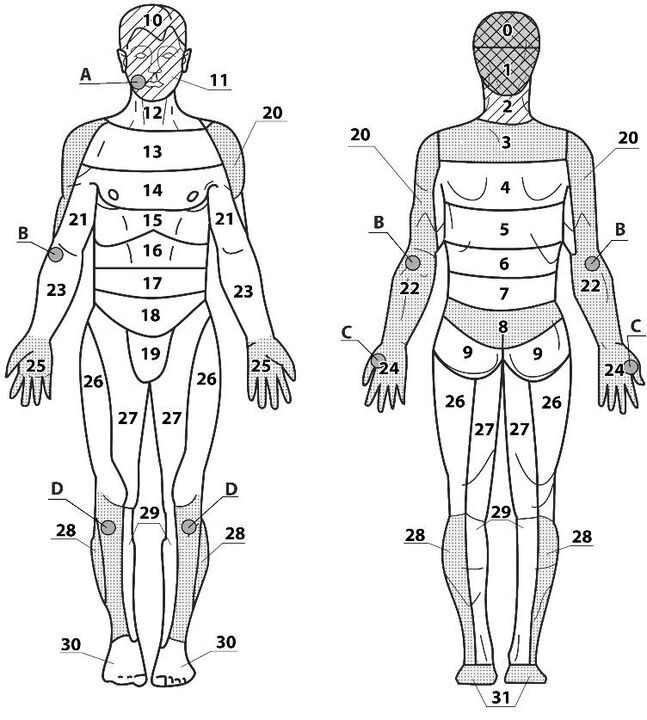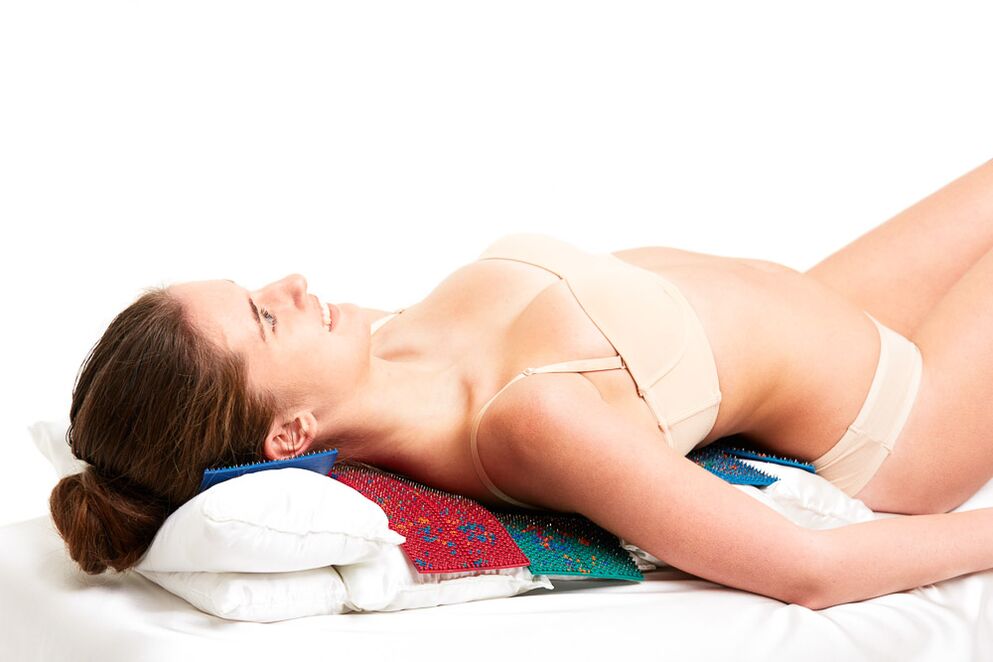Cervical osteochondrosis is a progressive dystrophic-degenerative lesion of the intervertebral disc in areas 1–7 of the vertebrae belonging to the cervical spine.
As a result of cervical osteochondrosis, deformity, fatigue, and then damage to the vertebral body occur. This disrupts the normal blood supply and nerve conduction in the neck and in areas defined by the nerve roots of the cervical spine.
Cervical osteochondrosis can be either isolated or combined with osteochondrosis of other parts - thoracic, lumbar and sacral.
Cause
Several factors influencing the development of osteochondrosis are distinguished. This includes:
- sedentary and sedentary lifestyle;
- type of inactive work with static load on the neck;
- overweight, inadequate physical development;
- connective tissue dysplastic process;
- circulatory disorders in the neck;
- neck injuries;
- scoliosis, poor posture, uncomfortable pillows and mattresses;
- hereditary predisposition, metabolic defects.
Symptoms of cervical osteochondrosis. Complications
The cervical spine is the most susceptible to the development of osteochondrosis. The vertebrae in it are the smallest compared to other parts of the spine, the muscular skeleton is not very noticeable, the weight of the head and the upright posture act on the vertebrae. In the cervical spine, the vertebrae fit closely to each other. Even minimal changes in them can cause compression and even displacement of nerves and blood vessels.
The most characteristic symptom complained of by patients is pain in the cervical spine. Depending on the affected area, pain can be localized: in the clavicle and shoulder; along the cervical spine; on the anterior surface of the chest.
The first signs of cervical osteochondrosis may be insignificant: a feeling of heaviness in the head, headache in the occipital area, pain in the neck in the evening, numbness or tingling in the shoulders and arms.
The main symptoms
Vegetative-dystonic.
Severe "shooting" pain in the neck, in the area just below the occiput. Pain occurs after a long stay in one position, after sleep, constant tension of the neck muscles.
Difficulty moving hands to the side, stiffness, numbness in the fingers. Due to the compression of the vertebral arteries, neurological manifestations are observed: headache, nausea, dizziness, unreasonable jumps in blood pressure.
Spinal symptoms.
The pain is located behind the sternum on the left side.
This type of pain should be distinguished from angina pain (with angina pectoris, nitroglycerin brings relief, with osteochondrosis it does not).
With the gradual disruption of the structure of the intervertebral disc, it is compressed and a violation of the nerve root occurs, as well as a narrowing or violation of the arteries and veins that pass through the vertebral body area.
This leads to the formation of special syndromes - radicular and ischemic:
- defeat of the root of the first cervical vertebra (C1): abnormalities in the occiput;
- C2 lesions give pain in the crown and occiput area;
- C3 lesions give pain in the neck from the side of the violation, decreased sensitivity in the tongue and hypoglossal muscles, speech disorders are possible;
- damage to C4 and C5 gives pain in the shoulders and collarbone, decreased tone of the muscles of the head and neck, hiccups, respiratory disorders and pain in the heart;
- C6 lesions occur most frequently, giving pain from the neck to the scapula, forearm, up to the thumb, skin sensitivity may be experienced;
- C7 lesions - symptoms similar to pain in the neck, back of the shoulders, up to the back of the hands, impaired arm strength and decreased reflexes.
Circulatory disorders due to compression of blood vessels in the cervical vertebrae can cause headaches, up to migraines, dizziness, visual disturbances and tinnitus, flies blinking in front of the eyes, disorders of autonomic function.
There may be manifestations of cardiac syndrome with pressing pain in the heart, shortness of breath and palpitations, rhythm disturbances.
Complications.
Protrusion of the intervertebral disc with the formation of a hernia (protrusion).
Rupture of the intervertebral disc by pinching of nerves and blood vessels, possibly compression of the spinal cord, which can be fatal.
Root lesions (radiculopathy), formation of the spine on the vertebral body (osteophytes) with manifestations of paresis and paralysis.
In the presence of the above complaints, it is necessary to contact an orthopedic specialist or neurologist, and conduct the necessary research.
Nutrition
Proper nutrition will significantly reduce the condition with osteochondrosis. Nutrition must be complete. If a person has a normal weight, then as a basis, you can take therapeutic diet number 15 according to Pevzner. It contains all the necessary minerals and increases the amount of fat and water -soluble vitamins. It is necessary to eat foods high in natural chondroprotectors. Chondroitin is found in red fish, tendons and cartilage of animals, and chicken meat.
Make sure you take clean water in the amount of 1. 5-2 liters. Fluid is needed to prevent the intervertebral disc from drying out.
Traditional and non -traditional treatments
Treatment
Today, there are traditional and non -traditional methods to treat osteochondrosis in the cervical spine.
Methods of drug treatment: symptomatic therapy with analgesics for pain relief; taking non-steroidal anti-inflammatory drugs to relieve inflammation and tissue edema; antispasmodic; drugs to improve blood circulation; chondroprotectors to restore the structure of the intervertebral disc.
Shown are a course of therapy of vitamin B group, external agents for therapy - gels and ointments, creams with anti -inflammatory, warming and analgesic components.
During the period of exacerbation, it is recommended to wear a special collar (Shants collar).
Complications of cervical osteochondrosis with intervertebral hernias that affect sensitivity and blood circulation can be treated immediately.
The duration of treatment depends on the neglect of the condition, as osteochondrosis is a progressive chronic disease. Treatment can be lengthy, and a course of prevention can run for a lifetime.
Physiotherapy treatment.
These include exercise therapy, magnetotherapy, balneotherapy, laser therapy, acupuncture, Lyapko application therapy and massage.
Physiotherapy
It is important to do exercise for the treatment of cervical osteochondrosis several times a day every day. They include self -stretching, self -massage, a set of special exercises. Avoid neck injuries and weight lifting.
It is necessary to combine prolonged sitting with a period of rest and warm -up.
The basis of cervical spine health is a strong and healthy back, physical activity, a comfortable bed with anatomical pillows and mattresses, proper posture and proper nutrition.
Lyapko application therapy

Application area:
- bases 2, 3;
- additions 1, 4, 12, 13;
- additional 20, 22, 28, 31.
General recommendations
When using the applicator, the main, auxiliary and maximum pain zones are used, but in cases of very significant pain, the applicator should be used above and below the painful zone, or points and zones on opposite sides should be used. Exposure time 10-30 minutes.

If cervical osteochondrosis is combined with osteochondrosis of other parts - thoracic, lumbar and sacral, then application therapy can be applied simultaneously or subsequently to all parts of the spine. The larger the area of exposure, the better the effect.















































